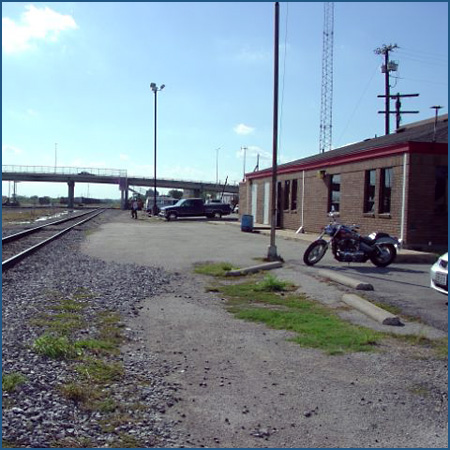()
The city was named for Edward Moses Taylor, an official with the International & Great Northern Railway. In anticipation of the railroad's arrival in 1876, parks, streets and a square were laid out.
- Facility Ownership: N/A
- Parking Lot Ownership: Union Pacific Railroad
- Platform Ownership: Amtrak
- Track Ownership: Union Pacific Railroad
Todd Stennis
Regional Contact
governmentaffairsnol@amtrak.com
For information about Amtrak fares and schedules, please visit Amtrak.com or call 1-800-USA-RAIL (1-800-872-7245).
The Amtrak station in Taylor consists of a platform adjacent to the old Union Pacific Railroad (UP) depot, a buff brick structure that houses active UP yard offices.
Taylor’s history is firmly rooted in the railroad. The city was named for Edward Moses Taylor, an official with International & Great Northern Railway (I&GN, later Missouri Pacific) official. On June 26, 1876, the IG&N reached Taylor Station, a small community in the vast cattle ranges of Central Texas. The name was then changed to Taylorsville and finally to Taylor in 1884. In anticipation of the railroad, the Texas Land Company laid out public parks, streets, and a square. The company then sold lots for prices ranging between $20 and $350. The railroad brought farmers and businessmen to Taylor, and the town began to produce large amounts of cotton. In 1882, the Missouri-Kansas-Texas (“Katy”) Railroad was extended to Taylorsville and joined with the Missouri Pacific (MP, now UP) to link east and west. In the 1980s, the majestic I&GN and MP station was demolished.
Taylor has an economy based in agriculture and manufacturing and is the most rural community in the Austin metropolitan area. The community takes pride in its ethnic diversity, which includes Czech, Polish, German, Scots-Irish, English, African-American, Hispanic, and Middle Eastern. The city boasts a wide array of restaurants, including famous barbecue. The community celebrates its diversity during the “Taylor History Days.”
The city’s many stately mansions reflect a time of affluence in Taylor’s history. The youngest governor of Texas, Dan Moody, was born in Taylor. His home, built in 1887, now serves as the Governor Dan Moody Birthplace Museum, which received Texas Historic Landmark status in 1968. Moody became governor in 1926 at the age of 33. He was also the first attorney in the United States to win a legal battle against the Ku Klux Klan.
Features
- ATM not available
- No elevator
- No payphones
- No Quik-Trak kiosks
- No Restrooms
- Unaccompanied child travel not allowed
- No vending machines
- No WiFi
- Arrive at least minutes prior to departure
Baggage
- Amtrak Express shipping not available
- No checked baggage service
- No checked baggage storage
- Bike boxes not available
- No baggage carts
- Ski bags not available
- No bag storage
- Shipping boxes not available
- No baggage assistance
Parking
Accessibility
- No payphones
- No accessible restrooms
- No accessible ticket office
- No accessible waiting room
- No accessible water fountain
- No high platform
- No wheelchair
- No wheelchair lift
Hours



 Amtrak established the Great American Stations Project in 2006 to educate communities on the benefits of redeveloping train stations, offer tools to community leaders to preserve their stations, and provide the appropriate Amtrak resources.
Amtrak established the Great American Stations Project in 2006 to educate communities on the benefits of redeveloping train stations, offer tools to community leaders to preserve their stations, and provide the appropriate Amtrak resources. Amtrak is seizing a once-in-a-lifetime opportunity to transform rail and Retrain Travel. By modernizing, enhancing and expanding trains, stations and infrastructure, Amtrak is meeting the rising demand for train travel. Amtrak offers unforgettable experiences to more than 500 destinations across 46 states and parts of Canada. Learn more at
Amtrak is seizing a once-in-a-lifetime opportunity to transform rail and Retrain Travel. By modernizing, enhancing and expanding trains, stations and infrastructure, Amtrak is meeting the rising demand for train travel. Amtrak offers unforgettable experiences to more than 500 destinations across 46 states and parts of Canada. Learn more at